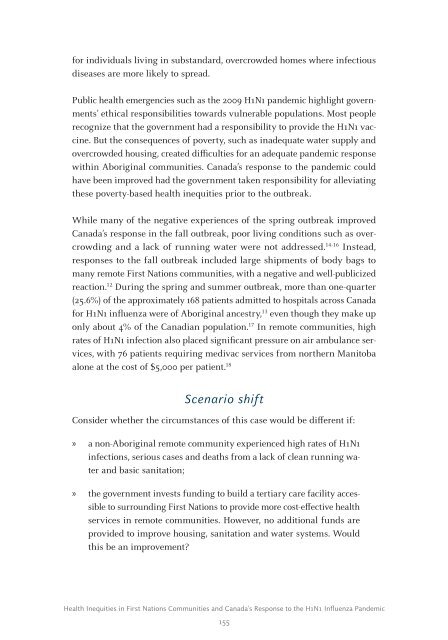PoPulationand Public HealtH etHics
PoPulationand Public HealtH etHics
PoPulationand Public HealtH etHics
Create successful ePaper yourself
Turn your PDF publications into a flip-book with our unique Google optimized e-Paper software.
for individuals living in substandard, overcrowded homes where infectious<br />
diseases are more likely to spread.<br />
<strong>Public</strong> health emergencies such as the 2009 H1N1 pandemic highlight governments’<br />
ethical responsibilities towards vulnerable populations. Most people<br />
recognize that the government had a responsibility to provide the H1N1 vaccine.<br />
But the consequences of poverty, such as inadequate water supply and<br />
overcrowded housing, created difficulties for an adequate pandemic response<br />
within Aboriginal communities. Canada’s response to the pandemic could<br />
have been improved had the government taken responsibility for alleviating<br />
these poverty-based health inequities prior to the outbreak.<br />
While many of the negative experiences of the spring outbreak improved<br />
Canada’s response in the fall outbreak, poor living conditions such as overcrowding<br />
and a lack of running water were not addressed. 14-16 Instead,<br />
responses to the fall outbreak included large shipments of body bags to<br />
many remote First Nations communities, with a negative and well-publicized<br />
reaction. 12 During the spring and summer outbreak, more than one-quarter<br />
(25.6%) of the approximately 168 patients admitted to hospitals across Canada<br />
for H1N1 influenza were of Aboriginal ancestry, 13 even though they make up<br />
only about 4% of the Canadian population. 17 In remote communities, high<br />
rates of H1N1 infection also placed significant pressure on air ambulance services,<br />
with 76 patients requiring medivac services from northern Manitoba<br />
alone at the cost of $5,000 per patient. 18<br />
Scenario shift<br />
Consider whether the circumstances of this case would be different if:<br />
» a non-Aboriginal remote community experienced high rates of H1N1<br />
infections, serious cases and deaths from a lack of clean running water<br />
and basic sanitation;<br />
» the government invests funding to build a tertiary care facility accessible<br />
to surrounding First Nations to provide more cost-effective health<br />
services in remote communities. However, no additional funds are<br />
provided to improve housing, sanitation and water systems. Would<br />
this be an improvement?<br />
Health Inequities in First Nations Communities and Canada’s Response to the H1N1 Influenza Pandemic<br />
155
















